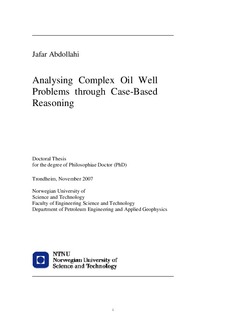| dc.description.abstract | The history of oil well engineering applications has revealed that the frequent operational problems are still common in oil well practice. Well blowouts, stuck pipes, well leakages are examples of the repeated problems in the oil well engineering industry. The main reason why these unwanted problems are unavoidable can be the complexity and uncertainties of the oil well processes. Unforeseen problems happen again and again, because they are not fully predictable, which could be due to lack of sufficient data or improper modelling to simulate the real conditions in the process. Traditional mathematical models have not been able to totally eliminate unwanted oil well problems because of the many involved simplifications, uncertainties, and incomplete information. This research work proposes a new approach and breakthrough for overcoming these challenges. The main objective of this study is merging two scientific fields; artificial intelligence and petroleum engineering in order to implement a new methodology.
Case-Based Reasoning (CBR) and Model-Based Reasoning (MBR), two branches of the artificial intelligence science, are applied for solving complex oil well problems. There are many CBR and MBR modelling tools which are generally used for different applications for implementing and demonstrating CBR and MBR methodologies; however, in this study, the Creek system which combines CBR and MBR has been utilized as a framework. One specific challenging task related to oil well engineering has been selected to exemplify and examine the methodology. To select a correct candidate for this application was a challenging step by itself. After testing many different issues in the oil well engineering, a well integrity issue has been chosen for the context. Thus, 18 leaking wells, production and injection wells, from three different oil fields have been analysed in depth. Then, they have been encoded and stored as cases in an ontology model given the name Wellogy.
The challenges related to well integrity issues are a growing concern. Many oil wells have been reported with annulus gas leaks (called internal leaks) on the Norwegian Continental Shelf (NCS) area. Interventions to repair the leaking wells or closing and abandoning wells have led to: high operating cost, low overall oil recovery, and in some cases unsafe operation. The reasons why leakages occur can be different, and finding the causes is a very complex task. For gas lift and gas injection wells the integrity of the well is often compromised. As the pressure of the hydrocarbon reserves decreases, particularly in mature fields, the need for boosting increases. Gas is injected into the well either to lift the oil in the production well or to maintain pressure in the reservoir from the injection well. The challenge is that this gas can lead to breakdown of the well integrity and cause leakages. However, as there are many types of leakages that can occur and due to their complexity it can be hard to find the cause or causal relationships. For this purpose, a new methodology, the Creek tool, which combines CBR and MBR is applied to investigate the reasons for the leakages. Creek is basically a CBR system, but it also includes MBR methods.
In addition to the well integrity cases, two complex cases (knowledge-rich cases) within oil well engineering have also been studied and analysed through the research work which is part of the PhD. The goal here is to show how the knowledge stored in two cases can be extracted for the CBR application.
A model comprising general knowledge (well-known rules and theories) and specific knowledge (stored in cases) has been developed. The results of the Wellogy model show that the CBR methodology can automate reasoning in addition to human reasoning through solving complex and repeated oil well problems. Moreover, the methodology showed that the valuable knowledge gained through the solved cases can be sustained and whenever it is needed, it can be retrieved and reused. The model has been verified for unsolved cases by evaluating case-matching results. The model gives elaborated explanations of the unsolved cases through the building of causal relationships. The model also facilitates knowledge acquisition and learning curves through its growing case base.
The study showed that building a CBR model is a rather time-consuming process due to four reasons:
1. Finding appropriate cases for the CBR application is not straightforward
2. Challenges related to constructing cases when transforming reported information to symbolic entities
3. Lack of defined criteria for amount of information (number of findings) for cases
4. Incomplete data and information to fully describe problems of the cases at the knowledge level
In this study only 12 solved cases (knowledge-rich cases) have been built in the Wellogy model. More cases (typically hundreds for knowledge-lean cases and around 50 for knowledge-rich cases) would be required to have a robust and efficient CBR model. As the CBR methodology is a new approach for solving complex oil well problems (research and development phase), additional research work is necessary for both areas, i.e. developing CBR frameworks (user interfaces) and building CBR models (core of CBR). Feasibility studies should be performed for implemented CBR models in order to use them in real oil field operations. So far, the existing Wellogy model has showed some benefits in terms of; representing the knowledge of leaking well cases in the form of an ontology, retrieving solved cases, and reusing pervious cases. | nb_NO |
